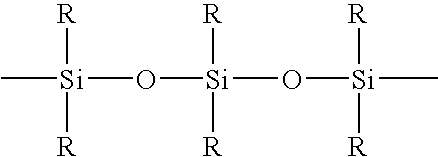Spray on bandage and drug delivery system
- Summary
- Abstract
- Description
- Claims
- Application Information
AI Technical Summary
Benefits of technology
Problems solved by technology
Method used
Image
Examples
example 1
[0176]A 0.0132 g portion of dried NTC2, 0.2495 g of dried TC2, and 1.1410 g of isopropyl alcohol (IPA) were placed in a 10 cc plastic coated glass vial. A continuous valve equipped with a solution gasket (The gasket was made from FLEXOMER™ 1085 polyolefin, available from Union Carbide, Danbury Conn.) was crimped onto the vial. Dimethyl ether (DME, 3.6273 g) was added to the vial through the valve stem. The vial was placed on a roller and allowed to mix. A clear solution was obtained. The specific formulations of the resulting fluid compositions (% weight / weight) are shown in Table 1, below.
[0177]The fluid composition was dispensed through a vertical actuator attached to a funnel shaped spacer onto microporous polyethylene film (CoTran™ 9710 from Minnesota Mining & Manufacturing, St. Paul, Minn.). The funnel was selected to provide test covering elements having a 5 cm2 surface area. The covering elements were allowed to dry at ambient conditions.
[0178]The surface tack of the dried co...
examples 2-13
[0179]Using the general method of Example 1, a series of fluid compositions was prepared and tested in which the amount and type of NTC and the amount of IPA were varied from composition to composition. The specific formulations of the fluid compositions (% weight / weight) are shown in Table 1, below. The fluid compositions of Examples 1-7 were prepared with NTC1; those of Examples 8-14 were prepared with NTC2. The fluid compositions of Examples 1, 2, 3, and 8 through 14 were clear solutions. The fluid compositions of Examples 4 through 7 contained a precipitate. The fluid compositions were shaken vigorously just prior to being dispensed. The tack values are given in Table 1 below where each value is the average of duplicate runs.
[0180]
TABLE 1FluidcompositionNTCTCIPADMETack (g)10.35.022.772.0020.45.026.767.9030.85.026.967.3041.05.021.872.2050.85.016.178.1060.45.016.178.5070.65.121.872.5080.25.022.072.8090.45.026.568.10100.85.026.767.50111.15.121.772.10120.84.916.078.30130.45.016.278....
example 15
[0181]A solution containing 6.2 percent by weight of NTC2 in IPA was prepared by diluting 0.5020 g of a 15% by weight solution of NTC2 in IPA with 7.5338 g of IPA. A 0.5118 g portion of the 6.2% solution and 0.2532 g of dried TC2 were placed in a 10 cc plastic coated glass vial. A continuous valve equipped with a solution gasket (The gasket was made from FLEXOMER™ 1085 polyolefin, available from Union Carbide, Danbury, Conn.) was crimped onto the vial. Dimethyl ether (DME, 4.2451 g) was added to the vial through the valve stem. The vial was placed on a roller and allowed to mix. The specific formulations of the resulting fluid compositions (% weight / weight) are shown in Table 2, below.
[0182]The fluid compositions were dispensed through a vertical actuator attached to a funnel shaped spacer onto microporous polyethylene film (CoTran™ 9710, Minnesota Mining & Manufacturing, St. Paul, Minn.). The funnel was selected to provide test covering elements having a 5 cm2 surface area. The cov...
PUM
| Property | Measurement | Unit |
|---|---|---|
| Percent by mass | aaaaa | aaaaa |
| Percent by mass | aaaaa | aaaaa |
| Percent by mass | aaaaa | aaaaa |
Abstract
Description
Claims
Application Information
 Login to View More
Login to View More - R&D
- Intellectual Property
- Life Sciences
- Materials
- Tech Scout
- Unparalleled Data Quality
- Higher Quality Content
- 60% Fewer Hallucinations
Browse by: Latest US Patents, China's latest patents, Technical Efficacy Thesaurus, Application Domain, Technology Topic, Popular Technical Reports.
© 2025 PatSnap. All rights reserved.Legal|Privacy policy|Modern Slavery Act Transparency Statement|Sitemap|About US| Contact US: help@patsnap.com



